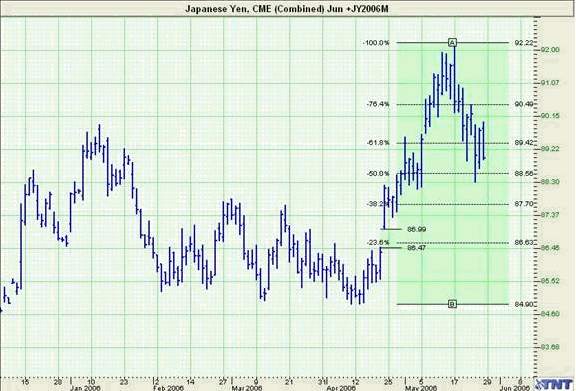Trade Description
Buy one June Japanese Yen 88 put & buy one June Japanese Yen 91 call for a cost of approximately 40 ticks ($500). Margin and max risk is the cost of the trade. Options expire Friday, June 9th, 2006. Please note that the strike prices may change as the trade is intended to strangle the price of the market. For instance, if the market is around 8850 then you would buy an 87 put and a 90 call.
Explanation
Strong price shifts in all currencies have occurred over the past several weeks as global interest rate policy changes have caused a major fundamental change in currencies. The yen is a primary focus of this fundamental shift not only because their own economy is allowing for interest rate policy changes that have been long overdue, but also because of the Asian exposure in US dollar denominated investments. Tomorrowâ�,��"�s FOMC minutes along with the announcement of Hank Paulson as the new Treasury Secretary sets up a week of explosive volatility in several key currencies â�,�“ with a possible mega bang to end the week with the monthly employment data. This yen strangle plays what is likely the best premium to volatility discount amongst the major currencies. The short time frame takes advantage of the short term nature of the expected volatility without being exposed to excessive cost, risk or margin.

Profit Scenarios
Profit scenarios vary by market activity and exit strategy, but in theory is unlimited. The concept behind the trade is that the movement of the market and the increase in value of one side of the strangle exceeds the total cost of the trade. However, if the market looks to have choppy price action, or to trade both positive and negative before the expiration of the options, then legging out of the trade when each side reaches profitability would yield maximum returns. It is recommended to exit one side on a profit of $300 over and above the cost of the trade, and to hold the other side for a possible reversal.
Risk Scenarios
Max risk is the cost of the trade. Time value works against you from the moment you enter the trade. To reduce exposure it is recommended that you enter into two spreads allowing you to exit 50% of the profitable half of the trade (for example, on a yen selloff, exit one of the two puts, and hold the two calls) when 75% of the total cost of both spreads occur. If a partial profit exit has not occurred by Monday (June 5) it is recommended to exit the entire spread to limit the net exposure.
James Mound is the head analyst for www.MoundReport.com, and author of the commodity book 7 Secrets. For a free email subscription to James Mound's Weekend Commodities Review and Trade of the Month, click here.
Disclaimer
There is risk of loss in all commodities trading. Commissions and fees vary per individual and therefore are not included in profit, cost and risk scenarios. Please consult a licensed broker before you trade for the first time. Losses can exceed your account size and/or margin requirements. Commodities trading can be extremely risky and is not for everyone. Some option strategies have unlimited risk. Educate yourself on the risks and rewards of such investing prior to trading. James Mound Trading Group, or anyone associated with JMTG or moundreport.com, do not guarantee profits or pre-determined loss points, and are not held monetarily responsible for the trading losses of others (clients or otherwise). Past results are by no means indicative of potential future returns.